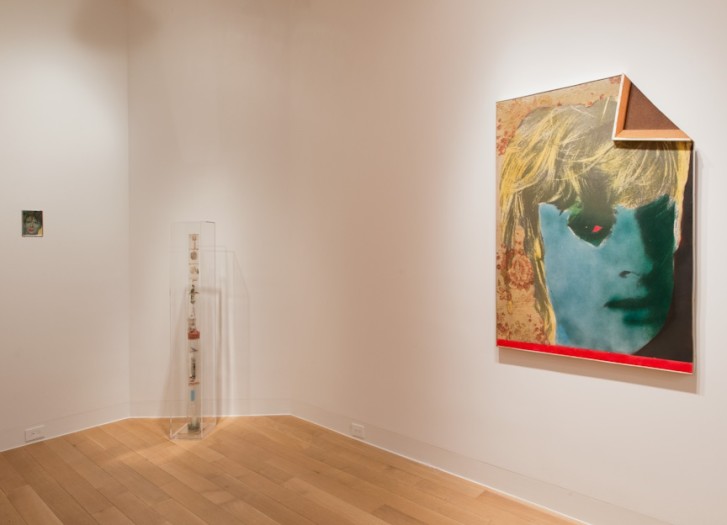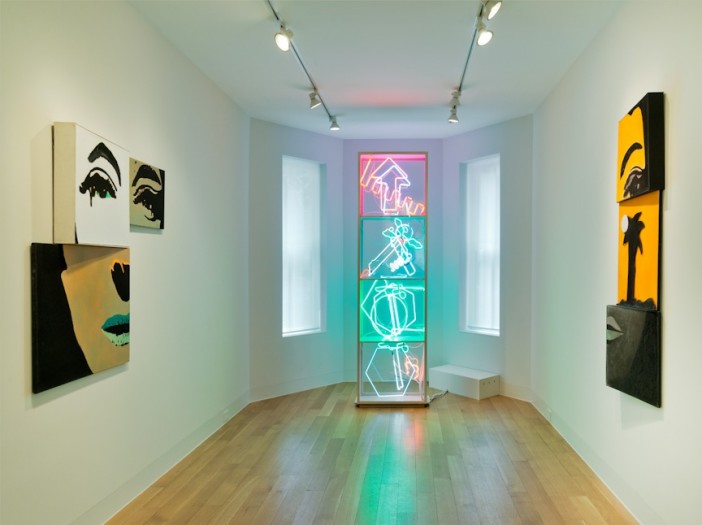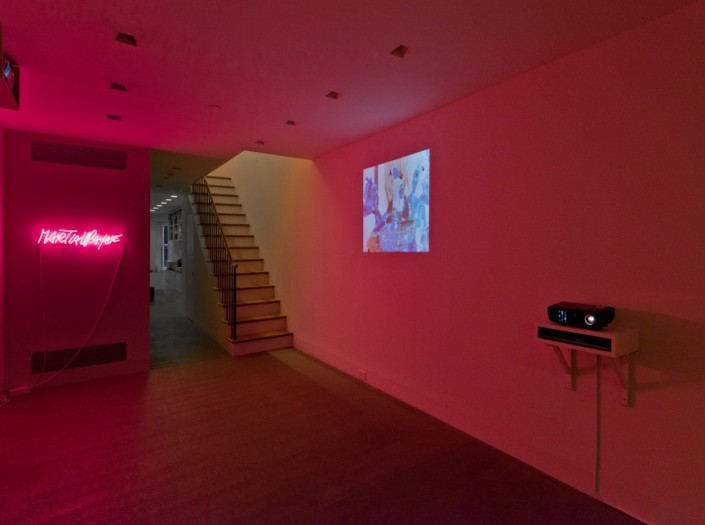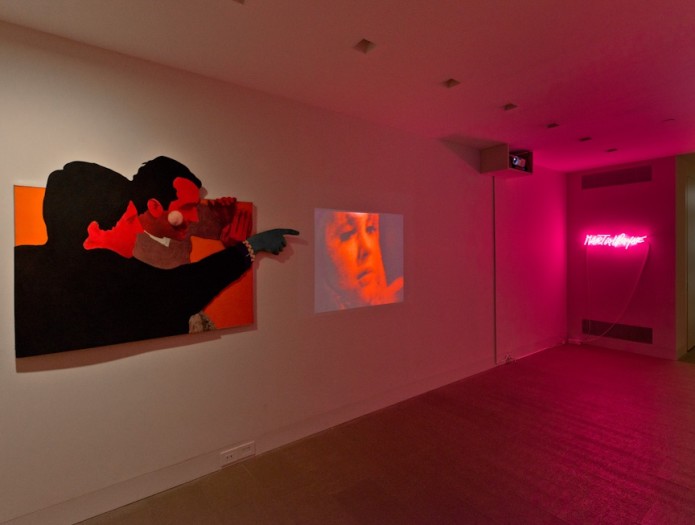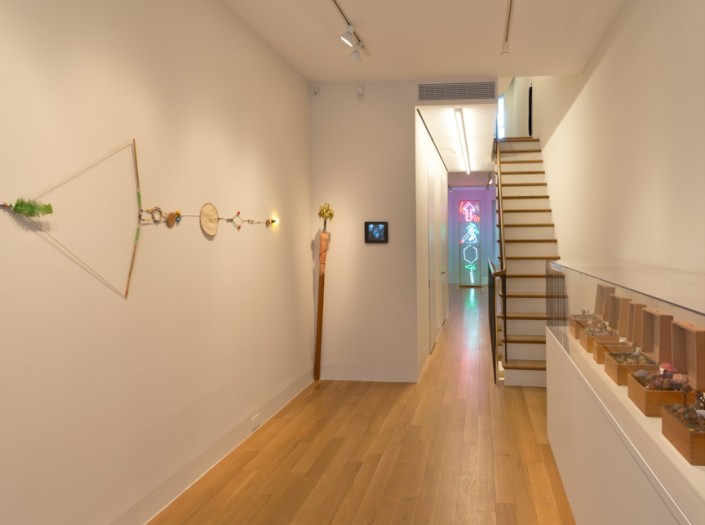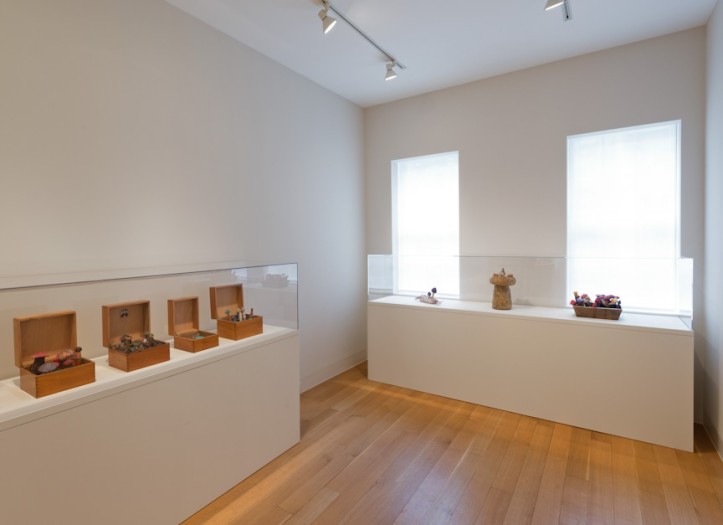In spite of his vital contributions to the European Neo-Avant-Garde, French artist Martial Raysse has been conspicuously under-represented in American art critical discourse. He is perhaps best known for early vivid paintings that appropriate images from advertisements, fashion magazines and familiar art masterpieces. With his signature palette of hyper-saturated colors and his unconventional incorporation of found objects and neon tubing on the surface of canvases, Raysse has been viewed until now through the lens of American Pop art – an altogether inadequate perspective on a seminal postwar artist who departed from Pop’s optimism and fascination with celebrity culture to introduce fresh, albeit disturbing, suggestions of real human confusion and growth behind the shiny surface of all things new.
Beginning May 11th 2013, Luxembourg & Dayan will present Martial Raysse: 1960 – 1974, the first U.S. exhibition in four decades devoted to this compelling figure. On view will be a group of rare early works by Raysse, including assemblages, paintings, sculptures and experimental films made during the first fifteen years of his career. The gallery will present an example of Raysse’s first Nouveau Réaliste assemblage objects from 1960; a selection of painterly depictions of iconic female beauty; and several poetic works from his much-mythologized ‘Coco Mato’ exhibition of 1974. Through these objects, Luxembourg & Dayan will look beyond the old characterizations of Raysse to investigate more thoroughly the aesthetic and conceptual ruptures that typify the artist’s practice.
Martial Raysse: 1960 – 1974 will remain on view through July 13th. It will be accompanied by the first English language catalogue devoted to the artist in more than 40 years and will include texts by Otto Hahn, Alison Gingeras, and Anaël Pigeat. Designed by Joseph Logan, the catalogue will feature previously unpublished archival material from the 1960s.
Martial Raysse was born into a family of ceramists in Vallauris in the South of France. From a young age, mass-produced materials, particularly plastic, fascinated him. An exhibiting artist by the end of the 1950s, Raysse developed what became known as his “hygiène de la vision” characterized by an intensive focus on consumer society. “I wanted my works to possess the serene self-evidence of mass-produced refrigerators… to have the look of new, sterile, inalterable visual hygiene,” he wrote. “Life is horrible. It’s evident that we are going to die. Thus we become even closer accomplices of all that bares within itself the seed of death… to use this as a means of arousing emotion is what I term speculation on cellular decay.”
By the mid-60s, Raysse had become critical of the conclusive discourse around Pop Art, with its Warhol Marilyns and upbeat shine. Considering that prevailing style to be a superficial codification of beauty, celebrating “idols not icons,” he responded with a parallel art in which the icy beauty of mechanically produced images and objects functioned as the central concern. In Raysse’s sanitized tableaux, the detritus of life in the commercial world is scrubbed, bleached, lit with neon and reconstituted. Acid-colored women and gleaming surfaces are vacuum-sealed inside flashing plastic obelisks built not to deify the past but to convey the troubling neutrality of the department store specialty counter.
Martial Raysse’s proto-Pop paintings and sculptures of this decade focused primarily upon the physical alterations he made to existing images of women, mostly anonymous models found in readily available fashion publications and ads (and, frequently, snapshots of his own wife France). In these early paintings Raysse obsessively examined the possibility of accessing beauty through artifice. His surfaces were alternately degraded and exaggerated, enlarged and cropped; their visual syntax was reframed or reordered in a way that rendered each resulting composition simultaneously more and less “real.” Martial Raysse: 1960 – 1974 will include several examples of such works.
The exhibition also features two of Raysse’s reprisals of iconic masterpieces, selections from the group of works known informally as his ‘Made in Japan’ series. Appropriating canvases by such figures as Ingres, Cranach, Gérard and Tintoretto, Raysse deployed photomontage, assemblage, neon and a garish palette to deform and degrade cherished emblems of high culture. The result is art that illustrates aphorisms Raysse was known to pronounce during this period. “One must push this falseness to its limit,” he declared. “Bad taste is the dream of too much wanted beauty.”
By the end of the 1960s and in tandem with his painting practice, Raysse began to make experimental films, some of which were projected on the surface of his pictorial compositions. Luxembourg & Dayan will screen five of these works as part of Martial Raysse: 1960 – 1974, including ‘Jesus Cola’ and ‘Homero Presto.’ They embody the spirit of the 1960s and dovetail with the art Raysse was making at the time of the French student protests of 1968 – a moment when shifting politics inexorably altered the formal trajectory of his career. Having lived in New York City for much of the previous decade, Raysse returned to Paris in 1968 to join the protestors at the Ecole des Beaux Arts, where he began working collectively on posters and propaganda connected to workers’ movements. His well-known Coco Mato works emerged as the direct result of the artist’s circumstances and radicalization.
In 1974, the Coco Mato “things” (Raysse prefers the word to more codified terms such as “sculpture”) were shown in an exhibition organized by the artist’s brother in a temporary space rented on Paris’s rue du Dragon. Taking their name from the Italian designation for red and white spotted mushrooms that have a hallucinatory and aphrodisiac effect, the Coco Mato things were precarious constructions made of paper mâché and such found objects as string, feathers, beads, clothespins, bits of plastic, and other shamanistic materials. Simplistic and aesthetically naïve, these works testify to Raysse’s ongoing investigation of the fragile relationship between nature and culture. With the deceptively benign painted mushroom confabulation ‘Le Sage sur le champignon’ (1970), and the delicate feather-and-light bulb wall piece ‘La Ligne’ (1973), the exhibition at Luxembourg & Dayan reveals an artist concertedly attempting to reassert humanistic ideals in the face of consumer society.


